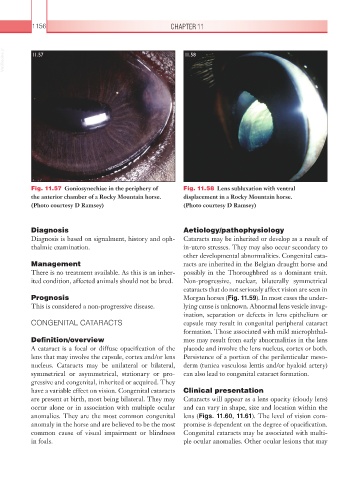Page 1181 - Equine Clinical Medicine, Surgery and Reproduction, 2nd Edition
P. 1181
1156 CHAPTER 11
VetBooks.ir 11.57 11.58
Fig. 11.57 Goniosynechiae in the periphery of Fig. 11.58 Lens subluxation with ventral
the anterior chamber of a Rocky Mountain horse. displacement in a Rocky Mountain horse.
(Photo courtesy D Ramsey) (Photo courtesy D Ramsey)
Diagnosis Aetiology/pathophysiology
Diagnosis is based on signalment, history and oph- Cataracts may be inherited or develop as a result of
thalmic examination. in-utero stresses. They may also occur secondary to
other developmental abnormalities. Congenital cata-
Management racts are inherited in the Belgian draught horse and
There is no treatment available. As this is an inher- possibly in the Thoroughbred as a dominant trait.
ited condition, affected animals should not be bred. Non-progressive, nuclear, bilaterally symmetrical
cataracts that do not seriously affect vision are seen in
Prognosis Morgan horses (Fig. 11.59). In most cases the under-
This is considered a non-progressive disease. lying cause is unknown. Abnormal lens vesicle invag-
ination, separation or defects in lens epithelium or
CONGENITAL CATARACTS capsule may result in congenital peripheral cataract
formation. Those associated with mild microphthal-
Definition/overview mos may result from early abnormalities in the lens
A cataract is a focal or diffuse opacification of the placode and involve the lens nucleus, cortex or both.
lens that may involve the capsule, cortex and/or lens Persistence of a portion of the perilenticular meso-
nucleus. Cataracts may be unilateral or bilateral, derm (tunica vasculosa lentis and/or hyaloid artery)
symmetrical or asymmetrical, stationary or pro- can also lead to congenital cataract formation.
gressive and congenital, inherited or acquired. They
have a variable effect on vision. Congenital cataracts Clinical presentation
are present at birth, most being bilateral. They may Cataracts will appear as a lens opacity (cloudy lens)
occur alone or in association with multiple ocular and can vary in shape, size and location within the
anomalies. They are the most common congenital lens (Figs. 11.60, 11.61). The level of vision com-
anomaly in the horse and are believed to be the most promise is dependent on the degree of opacification.
common cause of visual impairment or blindness Congenital cataracts may be associated with multi-
in foals. ple ocular anomalies. Other ocular lesions that may

